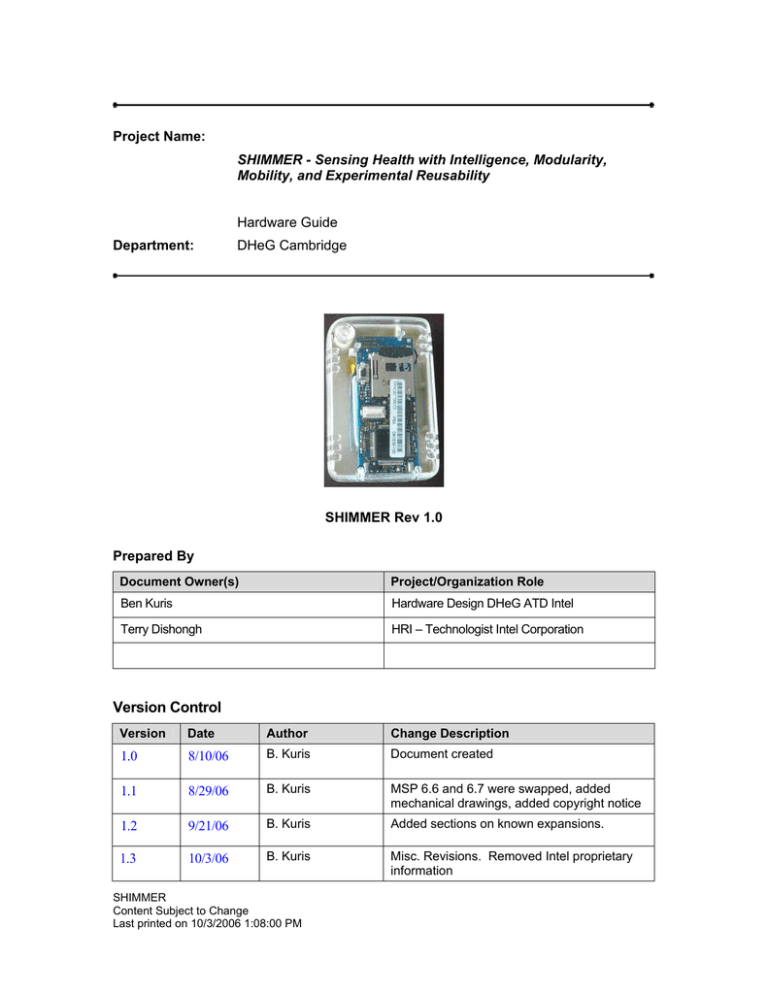
Project Name:
SHIMMER - Sensing Health with Intelligence, Modularity,
Mobility, and Experimental Reusability
Hardware Guide
Department:
DHeG Cambridge
SHIMMER Rev 1.0
Prepared By
Document Owner(s)
Project/Organization Role
Ben Kuris
Hardware Design DHeG ATD Intel
Terry Dishongh
HRI – Technologist Intel Corporation
Version Control
Version
Date
Author
Change Description
1.0
8/10/06
B. Kuris
Document created
1.1
8/29/06
B. Kuris
MSP 6.6 and 6.7 were swapped, added
mechanical drawings, added copyright notice
1.2
9/21/06
B. Kuris
Added sections on known expansions.
1.3
10/3/06
B. Kuris
Misc. Revisions. Removed Intel proprietary
information
SHIMMER
Content Subject to Change
Last printed on 10/3/2006 1:08:00 PM
Copyright © 2006 Intel Corporation
All rights reserved
SHIMMER Hardware Guide
Rev 1.3
Redistribution IS permitted provided that the following conditions are met:
Redistributions must retain the above copyright notice, and the following disclaimer. Redistributions in
electronic form must reproduce the above copyright notice, this list of conditions and the following
disclaimer in the documentation and/or other materials provided with the document.
Neither the name of the Intel Corporation nor the names of its contributors may be used to endorse or
promote products derived from this document without specific prior written permission.
THIS DOCUMENT IS PROVIDED BY THE COPYRIGHT HOLDERS AND CONTRIBUTORS "AS IS" AND ANY
EXPRESS OR IMPLIED WARRANTIES, INCLUDING, BUT NOT LIMITED TO, THE IMPLIED WARRANTIES OF
MERCHANTABILITY AND FITNESS FOR A PARTICULAR PURPOSE ARE DISCLAIMED. IN NO EVENT SHALL
THE COPYRIGHT OWNER OR CONTRIBUTORS BE LIABLE FOR ANY DIRECT, INDIRECT, INCIDENTAL,
SPECIAL, EXEMPLARY, OR CONSEQUENTIAL DAMAGES (INCLUDING, BUT NOT LIMITED TO,
PROCUREMENT OF SUBSTITUTE GOODS OR SERVICES; LOSS OF USE, DATA, OR PROFITS; OR BUSINESS
INTERRUPTION) HOWEVER CAUSED AND ON ANY THEORY OF LIABILITY, WHETHER IN CONTRACT,
STRICT LIABILITY, OR TORT (INCLUDING NEGLIGENCE OR OTHERWISE) ARISING IN ANY WAY OUT OF
THE USE OF THIS DOCUMENT, EVEN IF ADVISED OF THE POSSIBILITY OF SUCH DAMAGE.
1
Purpose
SHIMMER is the code name for a small sensor platform well suited to wearable applications.
The integrated 3-axis accelerometer, large storage, and low-power standards based
communication capabilities allow for standalone application as a robust motion capture device for
people and equipment. SHIMMER can also stream data to more-capable devices to expand the
scope of annotations.
The goal of SHIMMER is to provide an extremely compact extensible platform for long-term
wearable or wireless sensing in both connected and disconnected settings using proven system
building blocks. The design is realized using conventional design and assembly technology to
ensure repeatability and economy.
Page 2
10/3/2006
Copyright © 2006 Intel Corporation
All rights reserved
2
SHIMMER Hardware Guide
Rev 1.3
Capabilities Overview
Feature
Purpose
Component/Cabilities
Integrated
I/O
•
3 Axis Accelerometer using Freescale MMA7260Q
1.5/2/4/6g Micropower MEMs Accelerometer into
CPU A/D
•
4 Colored Status LEDs
•
Reset button
•
Hirose ST60 series 18 position rugged mobile
style external Header for charging, programming,
and tethered sensor extensions (12 multi-purpose
I/O connections).
•
Hirose DF12 series 20 position internal Expansion
Header for internal sensor daughter boards (14
multi-purpose I/O connections)
10Kbyte RAM, 48Kbyte Flash
Control operating state
Up to 8MHz
Provide best Signal quality
8 Channels of 12bit A/D
Operational alerts and messages
Extremely low power during periods of inactivity
Proven solution in medical sensing applications
Up to 2GByte currently available
NAND Flash based, ~20mA read/write power
Chipcon CC2420
GigaAnt Rufa 4.1dBi Antenna
Mitsumi WML-C46N CSR based design
Expansion
Capture of sensor and user data
MSP430F1611 CPU
Processing
Storage
No loss of data while mobile, during
network outages or while changing
batteries
MicroSD slot
802.15.4 Radio
Hi-reliability
Communication
Form factor
Operating Life
and Power
Standards Based Mobility
Class 2 Bluetooth™ Radio
Wearable
Long operating life
Easy maintenance and deployment
Page 3
Minimum Sensor volume is 1.75” x .8” x .5” and
10 grams without Bluetooth.
Comparable to a
lipstick
Initial durable enclosure is roughly the size of
“Zippo” lighter and has provisions for expansion
board and Bluetooth.
The enclosure can be
mounted in an MP3 player armband accessory.
Design target is 10 days while
channels at 50Hz w/250mAH battery.
sampling
6
“Deep Sleep” shelf life is >1 year per battery spec
Integrated Li-ion battery charger
Ability to monitor and indicate power status
10/3/2006
Copyright © 2006 Intel Corporation
All rights reserved
SHIMMER Hardware Guide
Rev 1.3
System Power
USART0 (SPI/I2C/Serial)
Internal
Expansion
External
Expansion
Bootsafe Loader
ADC x 2
SPI
RESET
MicroSD Flash Socket
ADC x 3
BSL USART0
ADC x 8
GPIO
ADC x 3
CPU
XYZ Accelerometer
USART1
SERIAL
SPI
Bluetooth Radio Module
802.15.4 Radio
Figure 1. SHIMMER System Interconnections
3
Embedded Programming Description
For design validation and testing TinyOS which uses the mspgcc Compiler is recommended.
TinyOS offers economy due to the extensive open-source code library for the Telos Mote
platform. Retargeting existing Telos applications to SHIMMER is one of the proficiencies of the
TinyOS environment and will greatly accelerate design bring-up and validation.
SHIMMER platform code has been released by Intel and is actively maintained at:
http://tinyos.cvs.sourceforge.net/tinyos/tinyos-1.x/
in contrib/handhelds
Current functionality includes:
Flash card operations
Reliable TCP/IP stack for 802.15.4
Telnet server
Http server
Accelerometer control
Real time clock module
LED control
Low voltage alert
Low-power ADC using DMA-mode
Page 4
10/3/2006
Copyright © 2006 Intel Corporation
All rights reserved
SHIMMER Hardware Guide
Rev 1.3
A Command Shell is in progress
4
Board Description
Pinout for External Expansion Connector:
Pin
Net Name
Function
1
PV_CHG
Battery Charging Power
5-6.5VDC at 300ma (limited by Internal Expansion connector
current rating)
2
SER0_RXD
USART0: Serial
3
SER0_TXD
USART0: Serial
4
SPI0_SCLK_EXP
USART0: SPI
5
SPI0_SOMI
USART0: SPI
6
SPI0_SIMO
USART0: SPI
7
JTAG_MSP_TCK
BSL programming
8
MSP_RESET_N
BSL programming and board reset
9
PV_1P8
Board power output: 1.8VDC
10
GPIO_EXTERNAL
Unspecified GPIO (suggested use is SPI chip select)
11
BSL_RX
BSL programming
12
VSENSE_ADC0
ADC input or GPIO
13
VSENSE_ADC7
ADC input, GPIO or DAC output
Page 5
10/3/2006
Copyright © 2006 Intel Corporation
All rights reserved
14
15
16
17
18
BSL_TX
SER0_RTS
SER0_CTS
PV
GND
SHIMMER Hardware Guide
Rev 1.3
BSL Programming
USART0: Serial
USART0: Serial
Board power output: 3.0VDC
Board Ground
Notes:
BSL_TX/RX can be used as GPIO
BSL_TX/RX and Serial CTS/RTS can be used as ext. interrupt lines
I2C is multiplexed onto SPI bus 0 lines.
Pinout for the Internal Expansion Connector. For function description previous table:
Net name
PV
GND
SER0_RTS
VSENSE_ADC6
VSENSE_ADC2
VSENSE_ADC1
BSL_TX
SER0_CTS
GPIO_INTERNAL
BSL_RX
Pin Number
1
2
3
4
5
6
7
8
9
10
Pin Number
20
19
18
17
16
15
14
13
12
11
Net Name
PV_1P8
GND
SPI0_SIM0
SPI0_SOMI
MSP_RESET_N
JTAG_MSP_TCK
SPI0_SCLK_EXP
SER0_TXD
SER0_RXD
PV_CHG
Notes:
BSL_TX/RX can be used as GPIO BSL_TX/RX and Serial CTS/RTS can be used
s ext. interrupt lines
I2C is multiplexed onto SPI bus 0 lines.
CPU Pin Assignment
TI MSP430F1611
Pin
POWER DVCC
AVCC
VREF+
VeREF+
DVSS
AVSS
VREFJTAG
TCK
TMS
TDI
TDO
RST_N
CLOCK
XIN
XOUT
Pin #
1
64
7
10
63
62
11
57
56
55
54
58
8
9
Name
PV_MSP
PV_MSP
PV_VREF_MSP
GND
GND
GND
GND
JTAG_TCK
No Connect
No Connect
No Connect
MSP_RESET_N
CLK_MSP_XIN
CLK_MSP_XOUT
Page 6
Use
Power
Power
A/D Ref
A/D Ref
Power
Power
A/D Ref
BSL
Not Routed
Not Routed
Not Routed
BSL, Button
Primary XTAL
Primary XTAL
Type
Analog
Analog
Analog
Analog
Analog
Analog
Analog
Input
N.C.
N.C.
N.C.
Open Drain
Clocking
Clocking
10/3/2006
Copyright © 2006 Intel Corporation
All rights reserved
PORT1
PORT2
PORT3
PORT4
PORT5
PORT6
XT2IN
XT2OUT
P1.0
P1.1
P1.2
P1.3
P1.4
P1.5
P1.6
P1.7
P2.0
P2.1
P2.2
P2.3
P2.4
P2.5
P2.6
P2.7
P3.0
P3.1
P3.2
P3.3
P3.4
P3.5
P3.6
P3.7
P4.0
P4.1
P4.2
P4.3
P4.4
P4.5
P4.6
P4.7
P5.0
P5.1
P5.2
P5.3
P5.4
P5.5
P5.6
P5.7
P6.0
P6.1
P6.2
P6.3
53
52
12
13
14
15
16
17
18
19
20
21
22
23
24
25
26
27
28
29
30
31
32
33
34
35
36
37
38
39
40
41
42
43
44
45
46
47
48
49
50
51
59
60
61
2
SHIMMER Hardware Guide
No Connect
No Connect
RADIO_FIFO
BSL_TX
RADIO_SFD
SER0_RTS
SER0_CTS
BT_PIO
BT_RTS
BT_CTS
GPIO_EXTERNAL
GPIO_INTERNAL
BSL_RX
1WIRE_PWR
1WIRE_DATA
ROSC
RADIO_FIFOP
RADIO_CCA
SPI0_CS_SDFLASH_N
SPI0_SIMO0
SPI0_SOMI
SPI0_SCLK
SER0_TXD
SER0_RXD
BT_TXD
BT_RXD
LED_RD_N
LED_OR_N
LED_YE_N
LED_GR_N
ACCEL_SEL0_N
ACCEL_SEL1_N
ACCEL_SLEEP_N
REG_1V8_EN_N
RADIO_SFD
SPI1_SIMO
SPI1_SOMI
SPI1_SCLK
SPI1_CS_RADIO_N
BT_RESET
NC_RADIO_VREG_EN
RESET_RADIO_N
VSENSE_ADC0
VSENSE_ADC1
VSENSE_ADC2
VSENSE_ACCEL_Z
Page 7
Optional XTAL
Optional XTAL
802.15.4
BSL
802.15.4
USART0: Serial
USART0: Serial
Bluetooth
Bluetooth
Bluetooth
Ext. GPIO or CS (SPI0)
Int. GPIO or CS (SPI0)
BSL
802.15.4 MAC
802.15.4 MAC
Unused
802.15.4
802.15.4
FLASH CS (SPIO0)
USART0: SPIO0/I2C
USART0: SPIO0
USART0: SPIO0/I2C
USART0: SERIAL
USART0: SERIAL
USART1: Bluetooth
USART1: Bluetooth
LED
LED
LED
LED
Accelerometer
Accelerometer
Accelerometer
Secondary Regulator
802.15.4
USART1: SPI1
USART1: SPI1
USART1: SPI1
802.15.4 CS (SPI1)
Bluetooth
802.15.4
802.15.4
Ext. GPIO or ADC
Int. GPIO or ADC
Int. GPIO or ADC
Accelerometer
Rev 1.3
Clocking
Clocking
Input (IRQ)
Output
Input (IRQ)
Output
Input (IRQ)
Output
Output
Input (IRQ)
Unassigned
Unassigned
Input
Output
Bi-directional
Pull-up
Input (IRQ)
Input (IRQ)
Output
Output
Input
Output
Output
Input
Output
Input
Output
Output
Output
Output
Output
Output
Output
Output
Input
Output
Input
Output
Output
Output
N.C.
Output
Unassigned
Unassigned
Unassigned
Analog Input
10/3/2006
Copyright © 2006 Intel Corporation
All rights reserved
P6.4
P6.5
P6.6
P6.7
3
4
5
6
SHIMMER Hardware Guide
VSENSE_ACCEL_Y
VSENSE_ACCEL_X
VSENSE_ADC6
VSENSE_ADC7
Accelerometer
Accelerometer
Int. GPIO, ADC or DAC
Ext. GPIO, ADC or DAC
Rev 1.3
Analog Input
Analog Input
Unassigned
Unassigned
4.1 Component detail for debug and testing
These components may be removed or replaced to support specific user applications, configure
the board, or perform power-measurement testing:
J1
J2
R25
U7
U9
EU6
R22
X1
X2
X3
R8
U2
U8
R23
EU5
U4
R9
EU1
R31
R29
R27
C37
C36
C35
J3
U3
SW1
D1
D2
D3
D4
J4
J5
Negative battery terminal
Positive battery terminal
Primary regulator bypass jumper. Remove U7 when using this option
Primary Regulator (3.0V LDO)
Secondary Regulator (1.8V LDO)
Battery charger (BQ24080)
Battery charger RSET
32.768 crystal
16.000 MHz crystal for 802.15.4
XT2 clock source (currently 8MHz resonator)
CPU power jumper (use for power measurements or additional filtering)
CPU (MSP430F1611)
Mitsumi WML-C46N footprint
1.8V power jumper (use for power measurements or additional filtering)
802.15.4 Radio (CC2420)
802.15.4 Antenna (RUFA)
Accelerometer power jumper (use for power measurements or additional filtering)
3-Axis Accelerometer (MMA7260Q)
Accelerometer x-filter
Accelerometer y-filter
Accelerometer z-filter
Accelerometer x-filter
Accelerometer y-filter
Accelerometer z-filter
MicroSD socket
Unique Silicon Serial ID# (DS2411)
Reset button
Green LED
Yellow LED
Orange LED
Red LED
Internal Expansion (DF128-20DS-0.5V)
External Expansion (ST80-18P)
4.2 Power
4.2.1
Requirements
Page 8
10/3/2006
Copyright © 2006 Intel Corporation
All rights reserved
SHIMMER Hardware Guide
Rev 1.3
Device operating life will depend on application and battery selection however design goal for use
as a long-term motion capture device is 1-10 days of operating life from a 250mAh cell while
recording 3-axis accelerometer data at 100 samples per second and periodically communicating
running status and bursts of data.
The design supports both Lithium-Ion/Lithium-Poly cell chemistry and lithium coin cells or alkaline
batteries. Device safety must be maintained by integrating battery polarity protection, charge
monitoring and failsafe battery over/under voltage and over-discharge limits in common mobile
environments and while AC-powered.
Expansion devices must be current limited according to the following projections:
Case
Primary current
Secondary current
No Restrictions
25mA
40mA
Bluetooth™ radio in
sleep mode
25mA
100mA
802.15.4 radio in
sleep mode
45mA
40mA
MicroSD flash
memory is idle
50mA
40mA
Notes
Sum of internal and
external expansion
connectors
60mA secondary
current savings is
additive in above
cases
20mA primary current
savings is additive in
above cases
25mA savings is
additive in above
cases
Operation beyond these recommended conditions while possible is not recommended without
detailed experimental analysis of both electrical and thermal design margin.
4.3
Design Choice
The device uses a diode wired-OR to prevent device damage from reversed battery leads and
allow operation from external power while charging. Depending on cell voltages the primary
regular can be populated or bypassed during top-level assembly.
The Texas Instruments BQ24080 Smart Li Charger is used for battery management. The
BQ24080 implements a multi-phase charge profile including battery conditioning and overcharge
protection currently. An Rset (R22) value of 6.49k provides C/2 charge limiting for a 250mAH
cell. All battery packs must provide failsafe protection against over/under voltage and overdischarge as a secondary protection.
5 Design Expansions
5.1
Expansion Modules
USB Charger Rev 1.0: Programming board using FTDI UM232 module (discontinued)
USB Charger Rev 2.0: Programming board, includes EEPROM, mini-USB type-B connector
GyroDB Rev 1.0: 3-axis Gyroscope + Tilt sensing for kinematics capture
ECG Rev. 1.0: 3-lead Micro-power ECG
AnEx Rev. 1.0: External Connector Breakout board with +/-5VDC Switched Capacitor Regulator
Page 9
10/3/2006
Copyright © 2006 Intel Corporation
All rights reserved
5.2
SHIMMER Hardware Guide
Rev 1.3
Recommended pin allocation
To ensure compatibility with existing SW and in cases where both internal and external expansion
devices are used, the following conventions are recommended:
External Expansion connector:
Pin 10 (GPIO_EXTERNAL) is pulled low on SHIMMER.
o pull high indicate presence of charging expansion
o USB Charger 2.0 and higher
o pulse high (button) as USER Attention signal to SHIMMER
o AnEx Expansion
Pin 14 (BSL_TX) reserved, power-enable/control for internal expansion
Pin 15 (SER0_RTS) power-enable/control for external expansion
o AnEx Expansion – High enables +/-5VDC regulator (recommended SW default: Low)
Pin 16 (SER0_CTS) for 1-wire EEPROM describing expansion
o USB Charger 2.0 and higher
Internal Expansion connector:
Pin 3 (SER0_RTS) reserved, power-enable/control for external expansion
o Used for optional TILYXY_N input on GyroDB
Pin 7 (BSL_TX) power-enable/control for internal expansion
o GyroDB Expansion – Low enables Gyroscopes (recommended SW default: High)
5.3
USB Charger / Programmer
The development charger/programmer is a USB-bus powered cradle using the popular FTDI
FT232 UART. Battery Charger status, USB Power, and UART activity indicators are present.
There is a reset button and user programmable button.
External Interface, pinout is:
SHIMMER Net name
SHIMMER Pin
Number
PV_CHG
1
Expansion Pin
Number
1
SER0_RXD
SER0_TXD
SPI0_SCLK_EXP
SPI0_SOMI
SPI0_SIMO
JTAG_MSP_TCK
MSP_RESET_N
2
3
4
5
6
7
8
2
3
4
5
6
7
8
PV_1P8
GPIO_EXTERNAL
9
10
9
10
BSL_RX
VSENSE_ADC0
VSENSE_ADC7
11
12
13
11
12
13
Page 10
Expansion Function
PV_CHG
(to SHIMMER)
No Connect
No Connect
No Connect
No Connect
No Connect
JTAG_MSP_TCK
MSP_RESET_N
(optional push button)
No Connect
GPIO_EXTERNAL
(User push button)
BSL_RX
No Connect
No Connect
10/3/2006
Copyright © 2006 Intel Corporation
All rights reserved
SHIMMER Hardware Guide
BSL_TX
SER0_RTS
SER0_CTS
14
15
16
14
15
16
PV
GND
GND
17
18
SHIELD
17
18
SHIELD/MTG pins
5.4
Rev 1.3
BSL_TX
No Connect
EEPROM_IO
(not supported on
Rev. 1.0)
PV (from SHIMER)
GND
GND
Gyroscope/Tilt Daughterboard
Internal expansion board for motion capture applications. The design uses a pair of InvenSense
IDG-300 gyroscopes. The flex segment wraps around the SHIMMER module to properly orient
the sensors for X/Y/Z measurement. There is an option to populate binary Tilt detection using
Omrom D6B sensors
Internal Interface, pin-out is:
SHIMMER Net name
SHIMMER Pin
Number
PV
1
GND
2
SER0_RTS
3
VSENSE_ADC6
4
VSENSE_ADC2
5
VSENSE_ADC1
6
BSL_TX
7
Expansion Pin
Number
20
19
18
17
16
15
14
SER0_CTS
GPIO_INTERNAL
BSL_RX
PV_VHG
SER0_RXD
SER0_TXD
SPI0_SCLK_EXP
JTAG_MSP_TCK
MSP_RESET_N
SPI0_SOMI
SPI0_SIMO
GND
PV_1P8
13
12
11
10
9
8
7
6
5
4
3
2
1
5.5
8
9
10
11
12
13
14
15
16
17
18
19
20
Expansion Function
PV Supply
GND
TILTXY_N
GYRO_Y
GYRO_Z
GYRO_X
GYRO_PWREN_N
(Low = Enabled)
TILTZY_N
No Connect
No Connect
No Connect
No Connect
No Connect
No Connect
No Connect
No Connect
No Connect
No Connect
GND
No Connect
ECG Daughterboard
Use this internal expansion board for ECG capture. The design uses CMOS operational
amplifiers and produces RA->LL and LA->LL vectors. RA->LA can be calculated on the host
CPU. Lead inputs have weak pull ups to detect floating electrodes.
Internal Interface, pin-out is:
SHIMMER Net name
SHIMMER Pin
Expansion Pin
Page 11
Expansion Function
10/3/2006
Copyright © 2006 Intel Corporation
All rights reserved
PV
GND
SER0_RTS
VSENSE_ADC6
VSENSE_ADC2
VSENSE_ADC1
BSL_TX
SER0_CTS
GPIO_INTERNAL
BSL_RX
PV_VHG
SER0_RXD
SER0_TXD
SPI0_SCLK_EXP
JTAG_MSP_TCK
MSP_RESET_N
SPI0_SOMI
SPI0_SIMO
GND
PV_1P8
5.6
SHIMMER Hardware Guide
Number
1
2
3
4
5
6
7
8
9
10
11
12
13
14
15
16
17
18
19
20
Number
20
19
18
17
16
15
14
13
12
11
10
9
8
7
6
5
4
3
2
1
Rev 1.3
PV Supply
GND
No Connect
No Connect
ECG_RALL
ECG_LALL
No Connect
No Connect
No Connect
No Connect
No Connect
No Connect
No Connect
No Connect
No Connect
No Connect
No Connect
No Connect
GND
No Connect
AnEx Daughterboard
AnEx is a simple external breakout board for prototyping and experimentation. Wire-solder vias
are provided for most signals and the outputs of a SW controllable +/-5VDC regulator (derived
from 3.0V rail).
External Interface, pinout is:
SHIMMER Net name
SHIMMER Pin
Number
PV_CHG
1
SER0_RXD
2
SER0_TXD
3
SPI0_SCLK_EXP
4
SPI0_SOMI
5
SPI0_SIMO
6
JTAG_MSP_TCK
7
MSP_RESET_N
8
PV_1P8
9
GPIO_EXTERNAL
10
BSL_RX
11
VSENSE_ADC0
12
VSENSE_ADC7
13
BSL_TX
14
SER0_RTS
15
Expansion Pin
Number
1
2
3
4
5
6
7
8
9
10
11
12
13
14
15
SER0_CTS
PV
GND
GND
16
17
18
SHIELD/MTG pins
16
17
18
SHIELD
Page 12
Expansion Function
No Connect
Wire Via
Wire Via
Wire Via
Wire Via
Wire Via
No Connect
Wire Via – RESET
No Connect
No Connect
No Connect
Wire Via
Wire Via
No Connect
REG5V_EN
(High = Enabled)
Wire Via
Wire Via – PV
GND
GND
10/3/2006
Copyright © 2006 Intel Corporation
All rights reserved
SHIMMER Hardware Guide
Rev 1.3
Additional wire vias are provided for:
+5V
-5V
There are also test pads for the unregulated output of the regulator’s switching capacitors (~2*PV
or 6VDC) located near C14 and C17 respectively.
5.7
Additional Daughterboard Designs
Modular connectors allow for choice of board height. The expansion board dimensions and keepout area are shown in the attached mechanical drawings. It is recommended to place tall
components (2.5mm max with 3.5mm mated connector height) on the SHIMMER side.
Page 13
10/3/2006
Copyright © 2006 Intel Corporation
All rights reserved
6
SHIMMER Hardware Guide
Rev 1.3
Mechanical Drawings
6.1
SHIMMER Enclosure, Outside Dimensions
6.2
SHIMMER Enclosure, Inside Dimensions
Page 14
10/3/2006
Copyright © 2006 Intel Corporation
All rights reserved
SHIMMER Hardware Guide
Rev 1.3
GyroDB, Kinematics sensor design is shown from top-view
Component height restrictions including mating dimensions.
Page 15
10/3/2006





